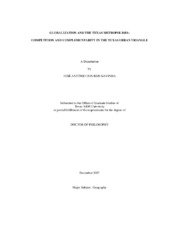| dc.description.abstract | This dissertation examines relationships between cities, and more specifically the largest
Texas cities, and the global economy. Data on headquarters location and corporation sales over
a 20-year period (1984-2004) supported the hypothesis that globalization is not homogeneous,
regular or unidirectional, but actually showed contrasted phases. Texas cities have been raising
in global rankings, due to corporate relocations and, to lesser extent, the growth of local
activities. By year 2004, Dallas and Houston ranked among the top-20 headquarters cities
measured by corporation sales The Texas Urban Triangle had one of the major global
concentrations of oil- and computer-related corporation headquarters; conversely, key sectors
like banking, insurance and automotive were not significant.
Standardized employment data in major U.S. metropolitan areas was examined through
principal components analyses. Overall, larger places showed higher degrees of diversity, and
no trend toward economic convergence. The TUT also presented a degree of intra-regional
diversity comparable to other urban regions. Findings confirmed the relevance of oil- and
information-related activities, along with construction, and weakness of activities linked to
finance and corporate management.
Traffic and air linkages in Texas cities were contrasted to other American gateways.
Dallas and Houston have been major nodes in global air transportation, with very important roles
as transit hubs for domestic (the former) and short international (the latter) flights. For long-haul
international traffic both cities were second-level American gateways, with Houston mobilizing
better connected to Western Europe and Mesoamerica, and Dallas to South America and East
Asia. Dallas central location strengthened its role in the domestic market, as the center of one of
the five major subsystems in the country and a top gateway in enplanements, number of linkages
and connectivity measures. The Texas air travel network hierarchical organization was relatively unbalanced, with two strong nodes at the top, three little-relevant middle nodes, and
several very poorly interconnected gateways at the bottom.
Finally, the high supply of regional flights between primary destinations, namely Dallas
and Houston, resulted in significant effects of time-space convergence. Such effects were only
found between highly-connected major gateways, and completely bypassed other places,
independently of their size and relative location. | en |


